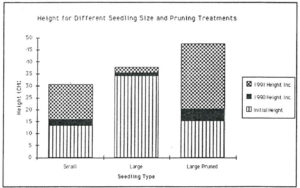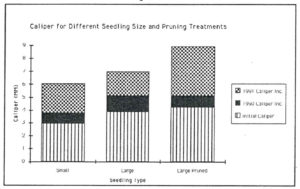Oaks ‘n’ Folks – Volume 7, Issue 2 – September 1992
Many of the native oak seedlings produced in California are grown in small containers or “liners” and transplanted to the field when they are one year old. While in the container, their root growth is severely restricted, and as a result, these seedlings have a much different size and configuration than naturally grown ones. With unrestricted root growth, native oaks typically develop a large, deep root system often before their shoots even emerge from the ground. For example, in a study at the U.C. Sierra Foothill Research and Extension Center, blue oak seedlings grown in deep boxes designed to monitor root growth had roots nearly 3-feet long after 5 months, while the shoots were less than 6 inches.
When root growth is restricted, the ratio of roots to shoots decreases and the seedlings may become out-of-balance. That is, the roots may be too small in relation to the top to provide adequate moisture and nutrient uptake when they are outplanted. Such seedlings may grow slowly or even die.
For some tree species, top pruning in the nursery (or just before outplanting) has been used to reduce the size of the shoot and restore a more favorable shot-root ratio. While cutting off part of the shoot reduces photosynthetic capacity, it also lowers moisture requirements by reducing transpirational surface. This may confer an advantage to seedlings planted in an environment where soil moisture is limiting.
While top pruning has been used successfully for several species of eastern and southern oaks, it has not been previously tested for any California species. This study examined how this practice would affect the field performance of container-growth blue oak.
Methods
Several hundred seedlings, grown from acorns collected from six adjacent blue oaks in Tehama County, were grown for one year in paper containers approximately 1.5 inches round and 8 inches tall. Prior to outplanting, seedlings were divided into two groups: 1) “small seedlings” that were between 4 and 8 inches tall, and 2) “large seedlings” seedlings that were between 10 And 14 inches tall. This latter group appeared to be too tall for the small containers and most likely to benefit from top pruning. The large seedlings were further divided into a group that was pruned to a 6-inch top and a group that was left unpruned. At the time, the pruning treatment seemed very drastic since it reduced seedlings height by more than 60%, leaving behind a short bare stem with no branches and few visible buds.
On each of three planting date, three 8-seedling rows for each of the treatments (small, large-unpruned and large-pruned) were planted on two-foot centers. During the next two years (1990 and 1991), survival, leaf-out date, height and caliper were recorded. Data were analyzed using analysis of variance.

Results
There were no significant differences in survival among the three treatments. Height growth, on the other hand, was strongly affected by top pruning. While top-pruned seedlings were initially quite small, by the end of the second field growing season, they were by far the tallest of any of the treatment groups (Figure 1). During both the first and second year they had significantly greater height increment than their unpruned counterparts.
Caliper exhibited a similar pattern (Figure 2). By the end of the second growing season, the caliper of top-pruned seedlings was significantly greater than the other treatment.

Leaf-out date was not consistent between years. After planting, the small unpruned seedlings leafed out approximately one week earlier than the other two groups. During the second year, however, the top pruned seedlings leafed out over a week earlier than the other treatment.
Conclusions
This study indicates that in certain circumstances, top pruning blue oak seedlings can improve field performance. While such pruning initially reduced height, pruned seedlings grew faster during the next two seasons, were significantly bigger after two years than seedlings from the other treatments, and generally appeared more vigorous. This treatment is especially recommended for seedlings that have grown tall and “leggy” and appear to have an out-of-balance shoot root ratio. While top pruning tended to initially cause seedlings to develop multiple shoots, most seedlings quickly reestablished dominant leaders and after two-and one-half years in the field, do not appear significantly bushier than unpruned ones.
prepared and edited by John M. Harper, Richard B. Standiford and John W. LeBlanc
